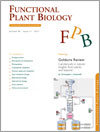
Functional Plant Biology
Volume 38 Number 11 2011
FPv38n11_EDPrometheusWiki: online protocols gaining momentum
Carotenoid pigments are essential in nature contributing to colour, aroma, hormone synthesis, photoprotection and photosynthesis in plants. In animals, carotenoids promote health, behavior, reproduction and contribute to survival. The biochemical pathway for carotenogenesis is now almost complete. This review will describe processes coordinating carotenoid accumulation, storage and degradation as well as highlight the importance of photostimulation, epigenetic regulation and metabolic feedback control in modulating composition and flux through the pathway.
FP11040Inherent nitrogen deficiency in Pistacia lentiscus preferentially affects photosystem I: a seasonal field study
The natural variation in leaf nitrogen contents of the mastic tree was exploited in order to investigate its effects on light reactions of photosynthesis under field conditions. It was found that nitrogen deficiency preferentially affects photosystem I throughout the seasons, while photosystem II is only affected during the adverse winter period. Adaptive trade-offs between reductive power- and energy-generating electron flows under nitrogen deficiency are inferred.
FP11083 Leaf stripe form of esca induces alteration of photosynthesis and defence reactions in presymptomatic leaves
Over the last decade, fungal grapevine trunk diseases such as esca have become the most threatening diseases of vineyards worldwide. Characterising the impact of esca on grapevine physiology showed that it can react precociously by reducing photosynthesis and triggering defence mechanisms. These data could represent a key step in locating a molecular target that could be used to control the disease.
FP11128 Evidence that banana (Musa spp.), a tropical monocotyledon, has a facultative long-day response to photoperiod
Seasonal temperature variation is the main environmental driver for the number of bunches of banana and plantain that appear each week during the year. We discovered that day length, independently of temperature, contributes to the seasonal distribution of bunch appearance in the tropics and subtropics. Bananas, a tropical monocotyledon, respond quantitatively to long days and this helps coordinate their reproductive development.
FP11141Patchy nitrate promotes inter-sector flow and 15N allocation in Ocimum basilicum: a model and an experiment
The ability of roots to conduct water changes with nitrate availability, but the consequences are poorly understood. We modeled how these changes affect nitrate transport from a nutrient patch, and experimentally tracked nitrate movement in hydroponic basil to test these predictions. Our results suggest that nitrate-induced increases in conductance cause a more even nitrate distribution in the crown.
FP11093 Morpho-structural and physiological performance of Sangiovese and Montepulciano cvv. (Vitis vinifera) under non-limiting water supply conditions
Climate change scenarios emphasises the importance of intraspecific traits variability. Key morpho-structural characteristics and physiological performance were evaluated in the two most cultivated Italian red grape cultivars. Some vine physiology-related traits greatly changed and it suggests different fitness in limiting and non-limiting conditions. Our data point out that intraspecific variability may offer a chance to face adverse environmental conditions related to climate change.
FP10240 Soil temperature moderates grapevine carbohydrate reserves after bud break and conditions fruit set responses to photoassimilatory stress
In grapevines, photosynthetic deprivation impairs the transformation of flowers to berries. Aiming to discover whether carbohydrates from root stores condition photosynthetic deprivation we found that soil warming increased the number of flowers while the proportion that became berries was strongly correlated with root carbohydrate levels. These responses reveal important influences of soil temperature on seasonal variation in grapevine fruiting.
FP11148 Root growth of lupins is more sensitive to waterlogging than wheat
Wheat and lupin often experience transient waterlogging in southwest Australia. The effects of waterlogging on wheat and lupin roots were characterised by examining patterns of root growth and changes in root anatomy and morphology. The greater tolerance of wheat roots to waterlogging than lupin roots was related to contrasting growth responses and anatomical features that affect internal oxygen deficiency and root hydraulic properties; attributes that influence root survival and recovery.
FP11070 Physiological and morphological factors influencing leaf, rhizome and stolon tensile strength in C4 turfgrass species
Sports turfgrass is often required to have a very high traffic resistance.Tensile strength tests and laboratory assays on C4 species' tissues highlighted the positive (lignin) and negative (starch and sugars) role of certain compounds on mechanical resistance. As such, turfgrass breeders can use these simple markers (i.e. starch) for predicting the mechanical strength of selected varieties and species.



